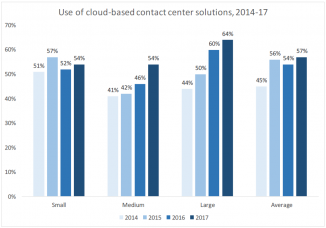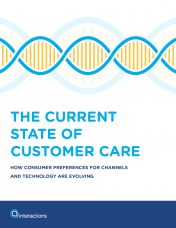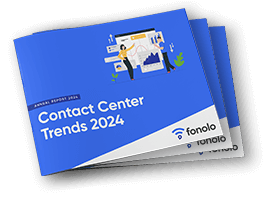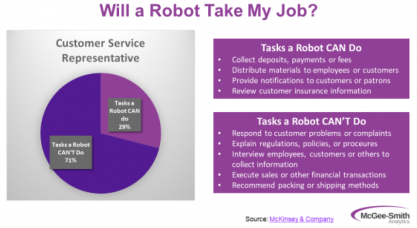 It’s going to be a big year in the world of contact center and in customer service technology. Will Avaya soar upwards, freshly unburdened from its decade of debt? Will this be the year that messaging platforms from Facebook, Apple and others reach critical mass as a channel for customer service? Will the AI / chatbot hype start to live up to its promise? We’re going to tackle all of those topics in the months ahead on this blog, but first we’re reading everything we can so we can bring you the most accurate analysis. Below are some of the reports that we have found most interesting.
It’s going to be a big year in the world of contact center and in customer service technology. Will Avaya soar upwards, freshly unburdened from its decade of debt? Will this be the year that messaging platforms from Facebook, Apple and others reach critical mass as a channel for customer service? Will the AI / chatbot hype start to live up to its promise? We’re going to tackle all of those topics in the months ahead on this blog, but first we’re reading everything we can so we can bring you the most accurate analysis. Below are some of the reports that we have found most interesting.
We’re delighted that so many of you subscribe to this blog or visit us every week. With so much content out there, it’s an honor that you make time for the Fonolo blog. If you haven’t subscribed, please do so. And feel free to let us know in the comments what kind of topics you’d like us to cover.
 The Inner Circle Guide to Cloud-based Contact Centre Solutions
The Inner Circle Guide to Cloud-based Contact Centre Solutions
Who wrote it: ContactBabel
Where to get it: http://www.contactbabel.com/reports.cfm
About: We are huge fans of ContactBabel. They consistently produce data-rich, unbiased reporting. This is the latest in their “Inner Circle” series which is based on industry surveys. (Their “Inner Circle Guide to Self-Service” was included in our last report round-up post.) If this topic interests you, you might want to check-out our post from 2 weeks ago The Hidden Power Structure of Cloud-Based Call Centers.
Key findings:
- “…one of the main differences to have occurred in the past five years is that cloud is now seen as a genuine alternative to CPE for even the largest of enterprises, not just smaller operations.”
- “..the outsourcing sector has been very quick to embrace cloud technology, with the very nature of their business is a cultural fit with the idea of letting a third-party take control of non-core…”
- “…There is still a large untapped market for cloud solutions though, with 56% of contact center respondents in our 2017 survey stating that they did not use any form of cloud-based functionality at all.”
Our favorite chart:

Reality and Promise of AI
Who wrote it: Sheila McGee-Smith (one of our Call Center Top Analysts), sponsored by NICE.
Where to get it: https://www.nice.com/engage/white-papers/The-Reality-and-the-Promise-of–Artificial-Intelligence-in-Customer-Care-111
About: There is a lot of confusion and muddled writing around AI and its adjacent topics. This brief report uses an interesting structure of comparing “The Reality” vs. “The Promise” for the topics of machine learning, chatbots, natural language processing, IoT and virtual reality. Sheila brings her decades of experience (and sharp-eyed skepticism) to the task, setting expectations at a more realistic level than what you might read in the popular press. (There’s some overlap with our recent post Chatbots Won’t Save Us From IVR Hell, we also covered chatbots in our most recent webinar.)
Key findings:
- “…The reason [machine learning. has not been deployed more widely has been the very high cost of such projects, often millions of dollars… getting a green light on such as project has typically not been easy…”
- “China Merchant Bank’s bot [served on WeChat] handles more natural customer conversations… 1.5 to 2 million interactions per day [which] …would typically require thousands of additional customer care agents to handle.”
- “McKinsey & Company’s … estimates that just 29 percent of a contact center agent’s job can be done by a robot.”
Our favorite chart:
The Current State of Customer Care
Who wrote it: Interactions
Where to get it: https://www.interactions.com/library/state-customer-care
About: This report presents the results from an online study, conducted in the Fall of 2017. Roughly a thousand consumers were asked questions about their experiences and preferences with customer care. One of the main focuses of the study is consumer channel preference. Many of their conclusions reinforce how much phone calls still play a central role, a topic we covered many times on the blog, most recently: Phone Calls are Still Essential to Customer Service.
Key findings:
- “…the phone is still an overwhelmingly predominant channel for consumers. In fact, when asked which contact methods they had ever used to reach out to customer service in the past, 79% said they had used the phone. In addition, 60% have used email and 34% have used some form of web chat.”
- “…17% of 18-29 year olds and 16% of 30-44 year olds have used social media [for customer service], compared to only 6% of 45-59 year olds and 3% of 60+ year olds.”
- “In industries such as finance/banking, healthcare, and utilities, consumers are turning to the phone more often than the overall average—74% used the phone for finance, 73% for healthcare, and 69% for utilities…”
Our favorite chart:
KPI Guide for Omni-Channel Contact Centers
Who wrote it: DMG Consulting, sponsored by Serenova.
Where to get it: https://www.dmgconsult.com/kpi-guide-for-omni-channel-contact-centers/
About: This report is a “deep dive” into the key performance indicators (“KPIs”) that are used by, or should be used by, a contact center. It is incredibly tough to run a contact center well because it entails both large-scale human management (which requires instinct and soft skills) and a very metrics-driven performance management (requiring a quantitative mindset and the ability to find patterns in the data). That latter challenge is made more difficult because of the sheer quantity of metrics that can be extracted. Which data is worth looking at? Which is really a “key” performance indicator? Author Donna Floss (one of our Call Center Top Analysts) brings her deep knowledge to illuminate this issue. For more on this topic, see our eBook Guide to Call Center Metrics.
Key findings:
- “To appreciate each customer’s experience, companies need to capture and evaluate what happens at every touch point and …transition from one touch point to the next. Enterprises need a new set of KPIs that measure performance in each channel as well as the cross-channel experience.”
- “Millennials comprise the largest group of employees in contact centers today… craves constant feedback… [so] share with agents the information they need so they can adjust their performance throughout the day.”
- “Agents should receive a performance scorecard on a weekly and monthly basis so that they see the bigger picture of their role in the organization.”
Our favorite chart:
We’re only going to include a small excerpt here because the heart of the report is a multi-page grid of 40 KPIs in 5 categories. For each KPI, it shows brief explanation and then indicates which roles in the contact center should see the data, and how often.

Discover the Contact Center Trends That Matter in 2024
Dig into industry trends and discover the changes that matter to your business in the year ahead.


